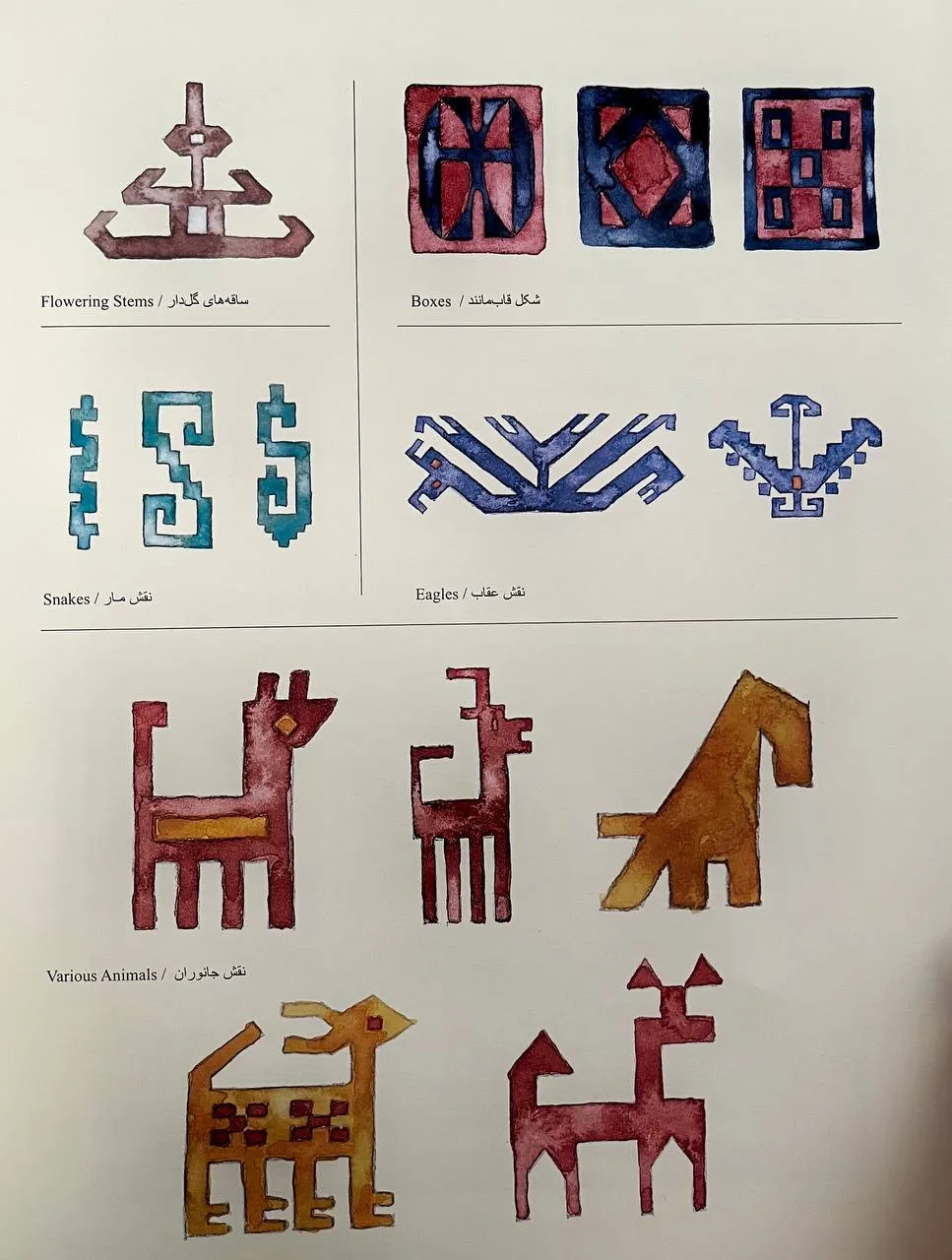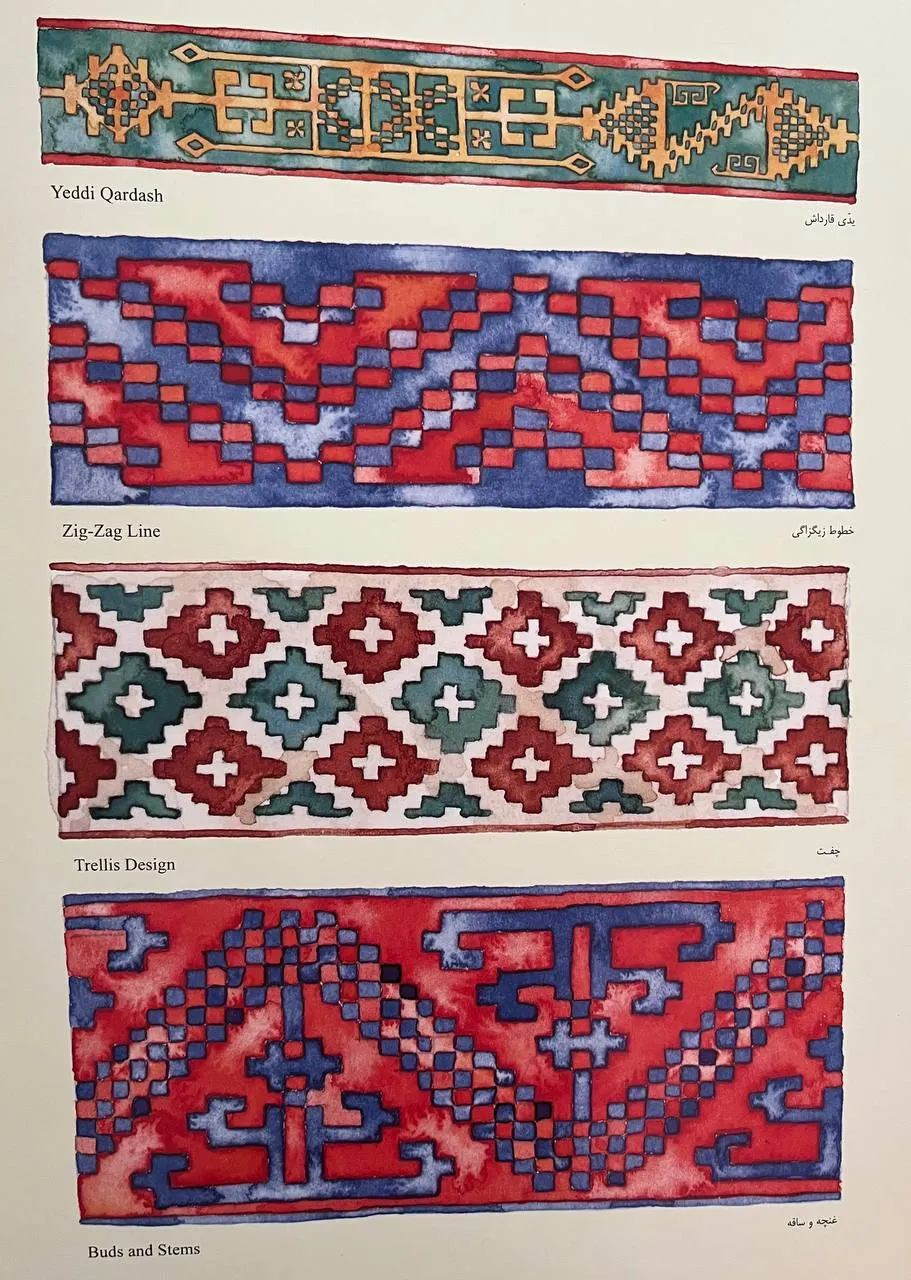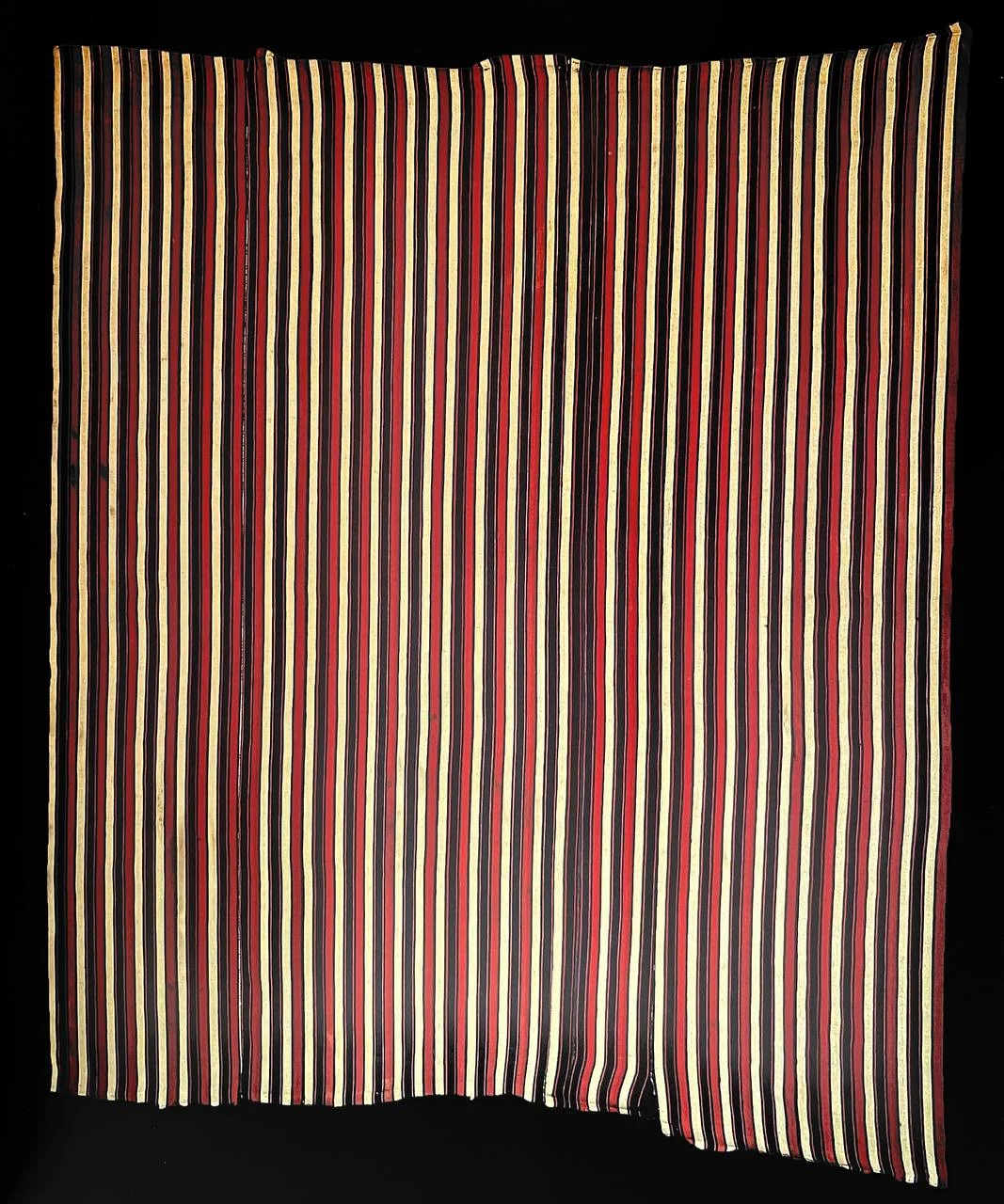Decorative traditions in Jajim fabric
The structure of the cloth, and the special decorative techniques used in making Decorative traditions in Jajim fabric severely limit the choices of decoration open to the Shahsavan weavers. Persian carpet

They cannot stray from the decorative tradition: that of multicoloured, vertical stripes of differing widths. The simplest and most common jajims have no decorations on them whatsoever. They are simply enlivened by the interplay of contrasting colours in the
stripes, which are often contrasted by narrow, dark-coloured borders.
*Click on the opposite link to see precious Iranian handmade and machine combined silk carpets*
Jajims of this type are very simply made and are generally used for the most mundane purposes. Often a sprinkling of small designs are added with warp-substitution techniques, in order to break up the monotony of the field. Alternatively, designs are embroidered once the jajim has been finished. Decorative traditions in Jajim fabric
On some jajims, the decorative traditions have been enriched by motifs applied to the cloth: multicoloured tufts of wool are inserted at intervals in the warps. Coins, butons, knotted tapes and other small objects may also be added. Each decoration then becomes a talisman.
Other jajims have more sought-after types of decoration, such as richly-decorated stripes with small, geometric designs, which are often extremely difficult to weave. The decorations
inevitably consist of sequences of tiny motifs. Sometimes they are rigidly arranged, according to a preordained scheme. persian Handmade carpet
Other times, the sequence of motifs is decided by the weaver herself, though the motifs are always from the tribe’s tradition. The motifs on some jajims are identical in each stripe. The
decorated stripes are separated from each other by narrower stripes with no decoration on them. On other jajims, the vertical stripes are adorned with two or more decorations, which are
repeated in series across the cloth. Decorative traditions in Jajim fabric.
The motifs used are linked to the decorative traditions of the tribe and are characterised by their small size, the repeated use of diagonals and by the ‘filigree’ effect which is created by the characteristic weaving techniques employed. Silk carpet
Among the decorative motifs used, the most common are simple, geometric shapes, such as the star, lozenge, octagon and triangle. These are reproduced in various sizes, with greater or lesser importance to the overall design. It is interesting to note that these motifs are considered talismans by Persian nomads and is probably why they are used in such profusion. Decorative traditions in Jajim fabric
Some motifs are inspired by plants and trees, though they are highly stylised, such as a stem with three corollas in strict sequence, and often linked together by a meander. Another example is a design of rounded, geometric corollas, surrounded by a thick profusion of petals. The boteh belongs in this group:
an almond-shaped motif with the tip curved to one side. It is one of the most common of all decorative motifs, and at the same time, one of the most mysterious in oriental textile production. Decorative traditions in Jajim fabric
It is generally thought that the motif was originally inspired by flowers, leaves or bushes. (In fact, boteh means bush’ in arsi.) However, Zoroastrian roots are often associated with it. The
shape is associated with a tongue of fire, the most important sacred symbol in the Zoroastrian faith. Decorative traditions in Jajim fabric.

Sometimes, everyday objects are included in the a jajim’s decorations. One example is the comb, the most important of a weaver’s tools, and the (geometrically-shaped) samovar. It is not uncommon to find figures, whether real or mythical, on a jajim. Two animals in particular are also included in this group; the eagle and the snake, both having a symbolic meaning. On jajims, the two animals appear separately and are not entwined in their mythical struggle, so often found in oriental iconography. Innovative return to old carpets in Iran
The serpent is one of the most important earthly divinities. It is lord of the waters and the protector of farming. It is usually portrayed as having a scaly skin, dragon-like claws and, most
importantly, a coiled body. The latter is usually geometrically- shaped to form a simple S.
The eagle, however, is the lady of light and symbol of the inviolability and supremacy of the sky. It is depicted from the front, with outstretched wings and is often double-headed. Jagged lines simulate the thick plumage and tiny hooks its fearsome beak and claws.
Among the most attractive decorative motifs are the human figures, which despite being highly stylised, are always extremely graceful. Sometimes they are placed beside a faintly- outlined tree. Other times, they are stacked one above the other inside a stripe, or otherwise hidden amongst the other designs. Historical changes styles of Persian carpet
The constraints of space and weaving technique give the figures a thread-like appearance. However, it is usually possible to distinguish the male figures from the female. The various figures are grouped by the weavers with great confidence and abandon. without necessarily referring to any preordained scheme. Decorative traditions in Jajim fabric
There are, however, some common, recurring composite designs. The Shahsavan women have a good repertoire of motifs and are able to produce both jajims decorated with the same composition on each stripe, and jajims with more than one composition on its stripes. These are alternated across the Weave. Decorative traditions in Jajim fabric.

The simplest composition is a basic tendril which zigzags along the length of the cloth. In places, it consists of just a thin line; in others it is thicker and more evident, with a tooth-edged profile or tiny squares inside its lines.
A second, common, motif occurs in several forms, some of which are more complex than others. It is based on the zigzagging tendril described above, but is embellished with floral compositions: stems and geometrically-shaped buds, which are placed inside each triangle of the zigzag. Decorative traditions in Jajim fabric.
The trellis designs are also very simple. Lozenges are arranged vertically in each of the narrowest bands, while the widest bands contain three or more rows of interlinking lozenges of various colours, each row separated by a line. Decorative traditions in Jajim fabric.
One particular group of jajims is characterised by thin stripes right across the field, each being decorated by an irregular series of tiny motifs, very similar to some letters of the Latin alphabet. The letters S’ and ‘0’ occur along with barred squares, lozenges or combs or ladders. Obviously, their similarity to the letters of the alphabet is purely coincidental, as they are largely unknown to the Shahsavan. Instead, these symbols have magical powers and help keep envy, the evil eye
and other evil forces from the jajim’s owner. Persian carpet designs
They are often distributed along a vertical stripe and mirrored by the same design on either side of the axis. A small Y-shaped design, arranged vertically, is called gushvareh or earring.
Geometrical designs of many different shapes are also very common. They are usually embellished with pendants and hooks, which sometimes bear a striking resemblance to the ornaments and jewels the tribe believe to be talismans.
Called hamian, they consist of triangular or rectangular-shaped pendants, decorated with droplets and chains, similar to those in which the nomads keep relics or Koranic verses. Rectangular- shaped buckles, bristling with protrusions, crucifix or star- shaped ornaments embellished with hook-like motifs are also common.
The number of designs which are considered amulets is not surprising. The same amuletic qualities can be applied to the designs on gabbehs and other weavings used for bedrolls.
According to local superstition, a person is most susceptible to the evil influences of hostile spirits whilst asleep. The weavers consider it sensible to cover all the items of bedding with good luck charms. Decorative traditions in Jajim fabric.
An evocative variation to the amulet motifs, and the only design to be called by the weavers’ own name for it, is the yeddi gardash border. The name literally means ‘seven brothers and consists of wide stripes divided into narrower bands. Large, S-shaped motifs made of tiny squares, perhaps representing a snake or maybe a stylised buckle, alternate with triangular- shaped ornaments or squares, decorated with tiny pendants.
Beside the main designs and along the edges, wind sinuous creatures which, from their mouths and long tails, can be interpreted as snakes. Similarly unmistakable are the snakes which adorn the inside of the stripes of some jajims. These may be accompanied by a zigzag tendril creating columns of’S’s. The tail, claws and open mouth of the serpent are alternated with long snakes with rigid coils, ending at both ends with stylised mouths.

Finally, the rare eagle border should be mentioned. Here the eagle motif alternates with the sun-bird motif, complete with beak and claws. Their wings are outstretched, and the birds are placed head to tail’ so that a zig-zag pattern is created.
